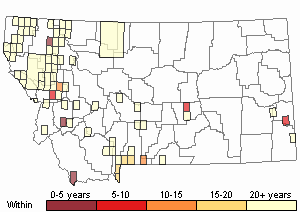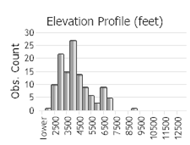View in other NatureServe Network Field Guides
NatureServe
Montana
Utah
Wyoming
Idaho
Wisconsin
British Columbia
South Carolina
Yukon
California
New York
Purple Horn-Tooth Moss - Ceratodon purpureus
General Description
Plants: Acrocarpous (Vitt 1988), growing in loose to crowded tufts or mats, chartreuse to pale green, green, deep green, typically darker below, frequently shaded with red, brown, or purple (FNA 2007) with age (Lawton 1971). Stems 0.2-4 cm (FNA 2007).
Leaves: Dense, nearly upright, or contorted or twisted, rarely straight when dry (FNA 2007), erect-spreading to spreading when moist, keeled (Lawton 1971), 0.35-2.8 mm in length, lanceolate to deltoid-lanceolate (FNA 2007); margins usually curved backward to near the apex, seldom flat, erratically toothed to smooth above; apex acuminate or acute, rarely obtuse; costa robust, extending almost to the apex or beyond it as a long awn (FNA 2007).
Leaf Cells: Median laminal cells usually thickened and curved at the cell angles (FNA 2007), the cells nearly square, short-rectangular, rounded, or uneven; basal cells a little larger (Lawton 1971).
Ceratodon purpureus subsp. purpureus: Present in Montana (FNA 2007).
Plants growing in loose to crowded tufts or mats, green, deep green, sometimes with brown tones, seldom chartreuse. Stems 0.3-4 cm. Leaves nearly upright to contorted when dry, seldom forming a tuft of crowded leaves at the stem tip, nearly upright to spreading when wet, 0.35-2.8 mm in length; margins typically toothed above; costa ending just before the apex to a little beyond (FNA 2007).
Ceratodon purpureus subsp. conicus:
Plants in dense mats, usually chartreuse. Stems 0.2-3 cm in length, usually 0.3-0.6 cm. Leaves straight to a little rotated when dry, typically forming a tuft of crowded leaves at the stem tip, spreading a little when moist, 0.6-1.2 mm in length; margins frequently smooth; costa forming a smooth long awn on many leaves, the awn occasionally the length of the leaf blade (FNA 2007).
Ceratodon purpureus subsp. stenocarpus:
Plants typically growing in extensive loose patches and mats, mostly chartreuse. Stems 0.3-4 cm in length, but mostly 0.6-1.4 cm. Leaves nearly upright to contorted or a little twisted when dry, seldom forming a tuft of crowded leaves at the stem tip, nearly upright to spreading when moist, 0.35-2.8 mm in length; margins typically toothed distally; costa extending to just before or a little beyond the apex (FNA 2007).
Phenology
Capsules ripen early summer to late autumn (FNA 2007).
Diagnostic Characteristics
The species displays much variation. Capsule orientation, costa length, leaf tip shape, and habit may vary within the same population (Lawton 1971).
Range Comments
Subspecies purpureus: Greenland; Canada: AB, BC, MB, NB, NL, NS, NT, NU, ON, PE, QC, SK, YT; USA: AK, AL, AR, AZ, CA, CO, CT, DC, DE, FL, GA, IA, ID, IL, IN, KS, KY, LA, MA, MD, ME, MI, MN, MO, MS, MT, NC, ND, NE, NH, NJ, NM, NV, NY, OH, OK, OR, PA, RI, SC, SD, TN, TX, UT, VA, VT, WA, WI, WV, WY; Mexico; Eurasia; Pacific Islands (FNA 2007). In Montana, known from Broadwater, Carbon, Carter, Cascade, Custer, Deer Lodge, Fallon, Flathead, Glacier, Gallatin, Granite, Glacier, Judith Basin, Lake, Lewis and Clark, Lincoln, Madison, Mineral, Missoula, Mussel Shell, Park, Powell, Ravalli, Rosebud, Sanders, Sweet Grass, and Valley Counties (Elliott 2016).
Subspecies conicus: Canada: BC; USA: ID, MN, OR, WA; Eurasia; n Africa; Atlantic Islands (FNA 2007).
Subspecies stenocarpus: AZ, CA, NM, TX; Mexico; West Indies; Central America; n South America; Eurasia; Africa (FNA 2007).
Observations in Montana Natural Heritage Program Database
Number of Observations: 258
(Click on the following maps and charts to see full sized version)
Map Help and Descriptions
Relative Density

Recency



 (Observations spanning multiple months or years are excluded from time charts)
(Observations spanning multiple months or years are excluded from time charts)
Habitat
In urban settings, this native species occurs in weedy areas, such as on top of roofs, in pavement fractures, and damaged land. In natural systems, it grows in disturbed places in montane and northern forests, and prefers sandy soils in exposed areas (Vitt 1988).
Subspecies purpureus: Soil, often on disturbed sites (Elliott 2016) and following fire, stony outcrops, tree bottoms, decaying wood. Elevation: Low to high (FNA 2007).
Subspecies conica: Soils plentiful in calcium in dry habitats. Elevation: Moderate (980-2600 feet) (FNA 2007).
Subspecies stenocarpus: Soil, soil following fire, tree bottoms. Elevation: Low to high (FNA 2007).
Ecology
Subspecies conica is prevalent in the semi-arid steppes of BC and c WA. In these dry regions, it is part of the biological crust community, along with low-growing Didymodon ssp. and Bryum spp. (FNA 2007).
Reproductive Characteristics
Dioicus (Flowers 1973). Seta in varying shades of yellow, ginger, or red, 1-4 cm tall. Capsule long and cylindric, 1-3 mm, smooth to strongly grooved when dry (FNA 2007); lid conic and tall to rostrate; calyptra (Flowers 1973). Perichaetia and perigonia at branch ends (Lawton 1971).
Subspecies purpureus: Seta typically deep brown or red. Capsule typically inclined to level, 0.8-3 mm, but mostly 1.3-1.8 mm, most often bowed, red to reddish brown or pale brown, sometimes with purple tones, strongly grooved when dry, usually with a swelling at the base of the capsule (FNA 2007).
Subspecies conicus: Seta yellow to orange. Capsule a little inclined to upright, typically straight, 0.8-2.2 mm in length, but mostly 1-1.8 mm, a sunny orange to pale brown, smooth to strongly grooved when dry, often with a small swelling at the base of the capsule (FNA 2007).
Subspecies stenocarpus: Seta light yellow to sunny orange. Capsule a little inclined to upright, typically bowed, 1-3.7 mm in length, but mostly 1.7-2.3 mm, light brown to sunny orange, smooth to strongly grooved when dry, with or without a small swelling at base of capsule (FNA 2007).
Stewardship Responsibility
References
- Literature Cited AboveLegend:
 View Online Publication
View Online Publication Elliott, J.C. and A.K. Pipp. 2018. A Checklist of Montana Mosses (1880-2018). Updated 3 January, 2020. Montana Natural Heritage Program, Helena, Montana. 73 pp.
Elliott, J.C. and A.K. Pipp. 2018. A Checklist of Montana Mosses (1880-2018). Updated 3 January, 2020. Montana Natural Heritage Program, Helena, Montana. 73 pp. Flora of North America Editorial Committee, eds. 2007. Flora of North America North of Mexico. Volume 27. Bryophytes: Mosses, Part 1. Oxford University Press, Inc., NY. xxi + 713 pp.
Flora of North America Editorial Committee, eds. 2007. Flora of North America North of Mexico. Volume 27. Bryophytes: Mosses, Part 1. Oxford University Press, Inc., NY. xxi + 713 pp. Flowers, S. 1973. Mosses: Utah and the West. Brigham Young University, Provo, Utah. 567 p.
Flowers, S. 1973. Mosses: Utah and the West. Brigham Young University, Provo, Utah. 567 p. Lawton, E. 1971. Moss Flora of the Pacific Northwest. Hattori Botanical Laboratory. Japan: Yamabuki-cho, Shinjuku-ku, Tokyo. 362 pages plus appendices.
Lawton, E. 1971. Moss Flora of the Pacific Northwest. Hattori Botanical Laboratory. Japan: Yamabuki-cho, Shinjuku-ku, Tokyo. 362 pages plus appendices. Vitt, D. J. Marsh, and R. Bovey. 1988. Mosses, Lichens & Ferns of Northwest North America. Seattle, WA: University of Washington Press. 296 p.
Vitt, D. J. Marsh, and R. Bovey. 1988. Mosses, Lichens & Ferns of Northwest North America. Seattle, WA: University of Washington Press. 296 p.
- Additional ReferencesLegend:
 View Online Publication
View Online Publication
Do you know of a citation we're missing? Elliot, J. C. 1993. Second checklist of Montana mosses. Unpublished report. U.S. Forest Service, Region 1. Missoula, MT. 45 pp.
Elliot, J. C. 1993. Second checklist of Montana mosses. Unpublished report. U.S. Forest Service, Region 1. Missoula, MT. 45 pp. Lawton, E. 1971. Keys for the Identification of the Mosses on the Pacific Northwest. Reprinted from 'Moss Flora of the Pacific Northwest'. Published as Supplement No. 2 of the Journal of the Hattori Botanical Laboratory. Nichinan, Miyazaki, Japan. 66 pp.
Lawton, E. 1971. Keys for the Identification of the Mosses on the Pacific Northwest. Reprinted from 'Moss Flora of the Pacific Northwest'. Published as Supplement No. 2 of the Journal of the Hattori Botanical Laboratory. Nichinan, Miyazaki, Japan. 66 pp.
- Web Search Engines for Articles on "Purple Horn-Tooth Moss"





